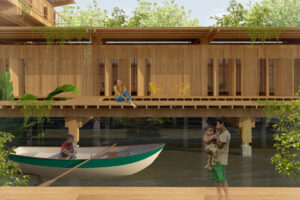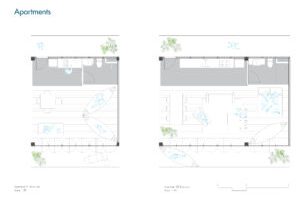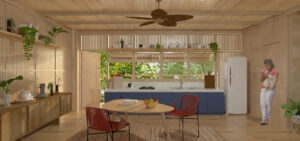







Social housing and cultural/commercial facilities for riverside communities living in precarious conditions in the city of Manaus, Amazonas – Brazil
Main objectives of the project
The project has the objective of providing housing for the impoverished riverside communities of Manaus (Brazil), living in precarious and risky situations.
Date
Stakeholders
- Architect: Danielle Khoury Gregorio
Location
Country/Region: Brazil
Description
The research is a criticism of the current production of social housing in Brazil, which creates generic models that ignore the social and cultural particularities of the Amazon region. Emphasizing the importance of rescuing the qualities of vernacular riverside architecture, the project incorporates features in its design familiar to residents of stilt and floating houses. Therefore, it allows the residents to identify with the house while valuing the Amazonian way of life and local knowledge.
Architecture takes shape according to the culture and not the other way around. The way this is done is by elevating the complex from the ground, as a reference to the popular stilt house. A floating floor, that varies in accordance with flood and ebb seasons, is also created, which is a common technique found in floating houses of the region, that allows for a continuous dialog with the local landscape. The housing complex not only offers quality housing but also spaces that foster culture and leisure activities, features essential for human development.
As a result, a sense of community is created and empowered. The access to those activities is intended for not only the residents of the complex, but also the surrounding communities. In that way, the project generates a micro local economy and cultural center for the region. Emphasis was placed on programs associated with job creation, in an educational and cooperative manner, using the local know-how to generate income. In order to reinsert the traditional practice of building fishing boats, a space in the building is reserved for a boat building school. A fruit shop and a fish market are located on the ground floor, incentivizing commerce of locally produced products.Also, a bakery school provides the community the opportunity of learning and working. An Environmental Education Center is created, providing learning spaces that enable educational actions aimed at raising public awareness about environmental issues. The project also holds a canoeing club, which incentivizes physical activities and reestablishes the relationship between men and water. Furthermore, there will be a recycling cooperative, generating employment and income while decreasing the amount of residues discarded in the environment. In addition, the building has ample external spaces, encouraging contact with nature and promoting community life. Aiming environmental sustainability, the project makes the best of available natural resources: the rain water is harvested and utilized in toilets. Sewage water is treated so it does not further pollute rivers and can eventually be reutilized. The solar energy is an alternative renewable energy used to provide electricity to the complex. Thermal comfort is done naturally by the dissipation of heat through cross ventilation. Also, the roof protects the interior spaces from direct rays of sunlight. The main structure of the building is made of reforested wood, which, during growth, absorbs carbon dioxide and generates less residues during construction phase. Furthermore, the building does not touch the ground, causing a smaller impact on the existing land and vegetation.
